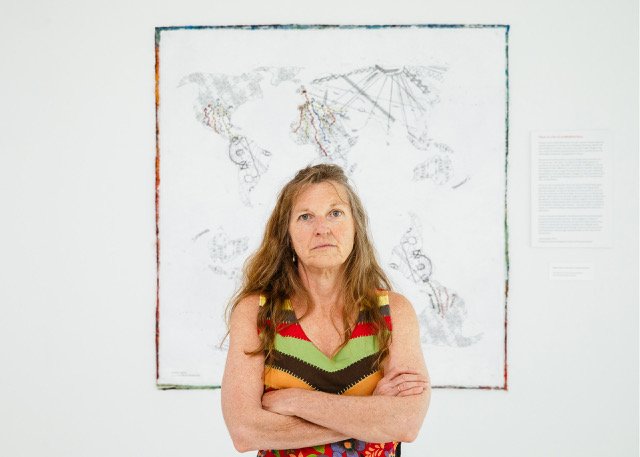And Then: Sandra Mayo’s Powerful Art
By Judy Bolton-Fasman for JewishBoston
“Beyond Trauma: Roots and Routes” is a new interactive exhibit at Brandeis University by local artist Sandra Mayo.
When I went to the Majdanek concentration camp near Lublin, Poland, it was in twilight, with a sooty silhouette. The shadows, even the ones I cast, startled me. I was with a group of people, yet I felt entirely alone. The number of Jews murdered at Majdanek is estimated to be between 50,000 and 78,000. Majdanek is also known for the butterflies the children carved into the walls of their barracks—butterflies etched with pebbles and fingernails. The butterflies have come to symbolize the 1.5 million children who perished in the Holocaust.
The world has always been tragic. But in the middle of the 20th century, in one of the most cultured countries in the world, Jews, Romani, LGBTQ people and the disabled were systematically exterminated. The world was silent except for the collective beating of hearts wild with fear. “Where was everyone?” I once asked my father, a World War II veteran. He quietly said, “We didn’t want to know.” When my father held me for the first time, on the second-to-last day of 1960, he must have been stunned that I arrived such a short time after the most devastating rupture in modern history. His brother-in-law was among the first wave of army physicians to liberate Buchenwald concentration camp. He didn’t tell anyone what he witnessed there until he was an old man.
The will to live, and the miracle of art, merge in local artist Sandra Mayo’s powerful creations. Mayo sees this combination as the foundation of resilience. Mayo, who is from Buenos Aires and makes her home in Lexington, has explored resilience in eclectic work abounding with bright, ingenious metaphors.
Her new interactive exhibition, “Beyond Trauma: Roots and Routes,” is part of the Leonard Bernstein Festival of the Creative Arts at Brandeis University and its theme of “buoyancy.” And the show’s title is much more than a pun—Mayo takes various emotional routes and risks in her work to plumb the roots of trauma, immigration, resiliency and sociopolitical events. As someone who lived through Argentina’s Dirty Wars of the 1970s and ‘80s, her work and the biographies she showcases have purposeful elements of trauma. “Life stories,” writes Mayo, “are a consequence of the geopolitical circumstances of our times.”
Mayo describes her work as “mixed media with a focus on printmaking and embroidery.” The two forms, she said, “bring pieces together that are a metaphor for listening to stories. And they represent how people keep stitching stories again and again. People internalize stories in the present. They change stories by adding something that resonates what they currently live with. Whatever resonates in the present moment, it gives another layer of meaning to their stories. That’s how people keep going; they reshape stories. This reshaping is what I am trying to capture.”
Read more at https://www.jewishboston.com/read/and-then-sandra-mayos-powerful-art/


